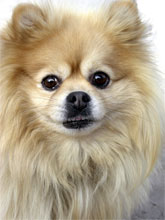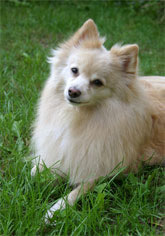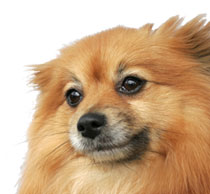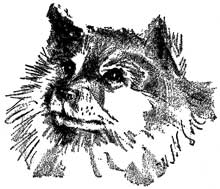|

 Mini-dog: At an average of 3 to 7 lb according to Mini-dog: At an average of 3 to 7 lb according to
AKC standards, the Pomeranian (Pom) is the
most diminutive of the northern breeds.
Foxy Fella: The head of the Pomeranian is wedge-shaped, making it somewhat foxy in appearance. The ears are small and set high. Its tail is characteristic of the breed and should be turned
over the back and carried flat, set high.
Royal Robes : The Pom's coat is its glory, consisting
of two coats, an undercoat and a top coat; the
first is soft, thick, and fluffy; the latter is long, straight and coarse. The undercoat is shed once
a year by males, and by intact females when
they are in season, after delivering a litter, and during times of stress. The AKC recognizes thirteen colors or color combinations: black, black & tan, blue, blue & tan, chocolate, chocolate & tan, cream, cream sable, orange, orange sable, red, red sable, and sable. The dogs that have 2 or more colors (usually mostly white, with others), are called "Parti-Color". The AKC also recognizes five "alternative" colors: Beaver, brindle, chocolate sable, white, and wolf sable.
 Balance Beem : One breed standard calls for a cobby, balanced dog. A cobby dog is as long or shorter than he is tall. A balanced Pomeranian fits together logically and in proportion. For instance, a small, delicately boned Pom with a large head looks unbalanced because his head type doesn't match his body type. A balanced Pom displays legs in proportion to his body: neither so short as to make him appear dumpy nor so long as to make him look like he is walking on stilts. Balance Beem : One breed standard calls for a cobby, balanced dog. A cobby dog is as long or shorter than he is tall. A balanced Pomeranian fits together logically and in proportion. For instance, a small, delicately boned Pom with a large head looks unbalanced because his head type doesn't match his body type. A balanced Pom displays legs in proportion to his body: neither so short as to make him appear dumpy nor so long as to make him look like he is walking on stilts.
This standard also calls for an expression that imparts great intelligence, showing that the Pom has an alert character and that he behaves accordingly. The pom's alertness makes him a superb watchdog.

Miniature Watchdogs: The Pomeranian is an active dog who is intelligent, courageous, and a loyal companion. The Pomeranian may not interact well with small children, and due to its small size can suffer abuse from children. Pomeranians have proven themselves to be excellent watchdogs by announcing intruders with loud, sharp barks. The Pomeranian easily adapts to life in the city, and is an excellent dog for country living with its strong hunting instincts from its wild ancestors. Pomeranians are generally a healthy, hardy, and long-lived breed—Poms often live 12 to 16 years or so.
 Possible side effects are... : The most common problem in Pomeranians is luxating patella. Also Legg-Calvé-Perthes syndrome and hip dysplasia can occur, but are rarer in this small breed. Patent ductus arteriosus (a heart disease) and collapsing trachea have become serious problems in Poms. Dry eye, tear duct disorders and cataracts that can appear in young adulthood and often lead to blindness are also common. Skin diseases are quite common, especially allergies (that oten leads to acute moist dermatitis or "hot spots") and follicular dysplasia (also known as alopecia X). Other problems that occur regularly include hypothyroidism, epilepsy, and hypoglycemia. Occasionally, hydrocephalus can occur in Pom puppies. Poms, like many Toy breeds, are prone to bad teeth and harmless episodes of reverse sneezing. Possible side effects are... : The most common problem in Pomeranians is luxating patella. Also Legg-Calvé-Perthes syndrome and hip dysplasia can occur, but are rarer in this small breed. Patent ductus arteriosus (a heart disease) and collapsing trachea have become serious problems in Poms. Dry eye, tear duct disorders and cataracts that can appear in young adulthood and often lead to blindness are also common. Skin diseases are quite common, especially allergies (that oten leads to acute moist dermatitis or "hot spots") and follicular dysplasia (also known as alopecia X). Other problems that occur regularly include hypothyroidism, epilepsy, and hypoglycemia. Occasionally, hydrocephalus can occur in Pom puppies. Poms, like many Toy breeds, are prone to bad teeth and harmless episodes of reverse sneezing.
Brush three times daily : Coat care for the Pomeranian is similar to the Pekingese. A daily or twice weekly brushing is essential to keep the thick, plush coat, which sheds seasonally, free of nats. Regular ear and nail care is recommended, along with peak seasonal bathing. Pomeranians are prone to teeth problems, and it is reccomended that their teeth be brushed at least once a week. Ideally, their teeth should be brushed daily.

An honest day's work: The Pomeranian originated from the sled dogs of Iceland and Lapland, which were eventually brought into Europe in Pomerania. This region, bordered on the north by the Baltic Sea, has been under the control of the Celts, Slavonic, Poland, Sweden, Denmark and Prussia, at various times.
This region extends from the west of the
Ruegen Island to the Vistula river—there it became popular both as a pet and working dog. Breeders in Pomerania improved the coat and bred the dogs down for city living, but they were still 20 pounds or more when they reached England.
 A Queen's best friend: English breeders, through trial and
error and Mendelian theories, are credited for reducing the dog's size and A Queen's best friend: English breeders, through trial and
error and Mendelian theories, are credited for reducing the dog's size and
developing the many colors. The Pomeranian of today is small due to selective breeding, but the breed
still retains the hardy disposition and thick coat typical of dogs in cold climates. Queen Charlotte first
introduced the the Pomeranian to
English nobility, however; the Pom gained international popularity when her granddaughter—Queen Victoria returned from
vacation in Florence, Italy with a
Pomeranian
named Marco.
All text is available under the terms
of the GNU Free Documentation License
|
